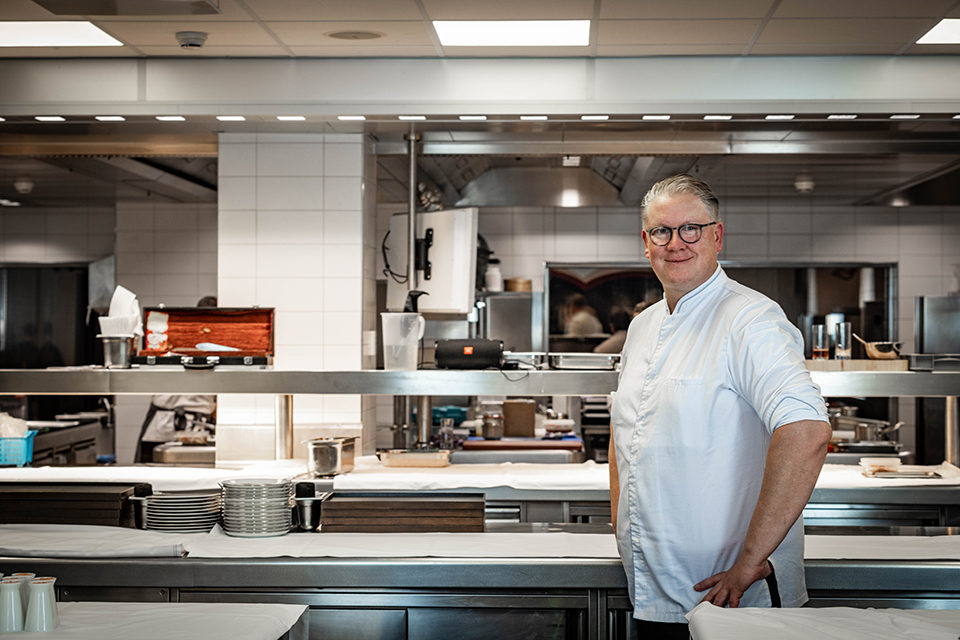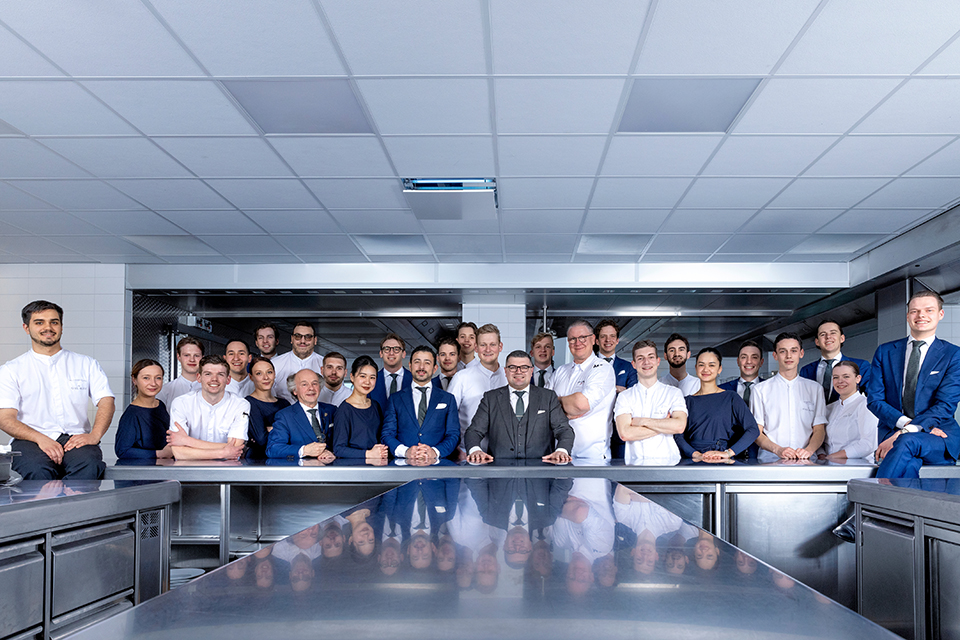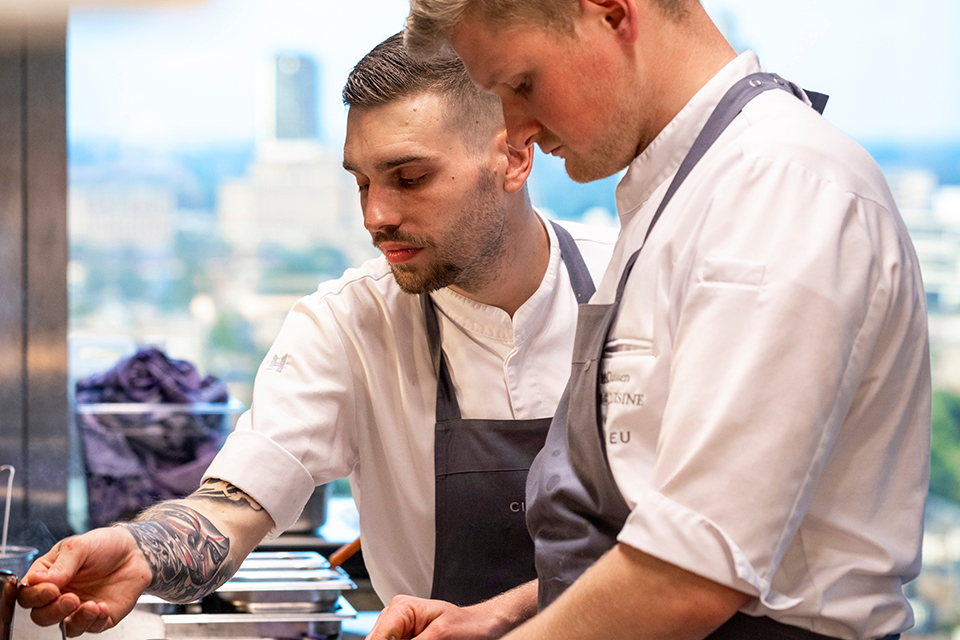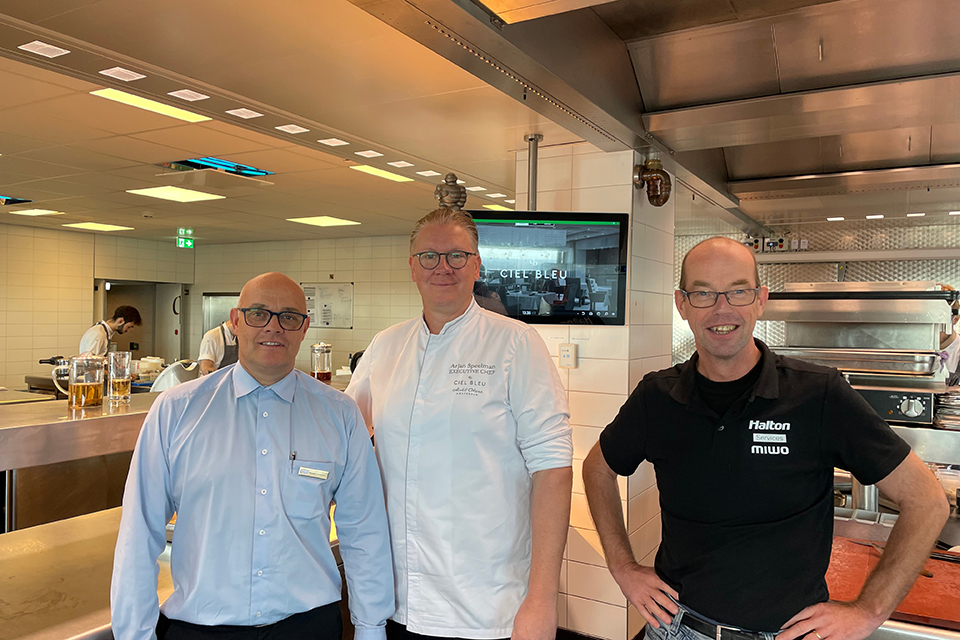
High-level cooperation
How to create the best indoor climate in world-class kitchens
High above the city, with a magnificent view over Amsterdam, on the 23rd floor of Hotel Okura Amsterdam, is a place where cooking is literally and figuratively at the very highest level: this is where Executive Chef Arjan Speelman runs the kitchen brigade of Ciel Bleu, the restaurant that has had two Michelin stars since 2007. In such a top kitchen, not only the people and the products are of the very best quality, but also the equipment. Not for nothing is there a kitchen ventilation system here - tightly concealed in the stainless steel and aluminium ceilings - from market leader Halton.
Hotel Okura Amsterdam values hospitality and culinary expertise. Because in addition to Ciel Bleu Restaurant, Hotel Okura also houses Yamazato, a traditional Japanese restaurant awarded one Michelin star. Sazanka Restaurant, the teppanyaki restaurant, is also very popular. Serre Restaurant, open for lunch and dinner, has a casual setting and international cuisine and a Bib Gourmand listing, which stands for excellent value for money. Furthermore, guests can enjoy an extensive breakfast buffet at Le Le Camelia Restaurant. Finally, there is also a fantastic bar, Twenty Third Bar, renowned for its impressive selection of cocktails.

World top
Top catering cannot exist without sophisticated and meticulously maintained kitchens. And in this, it is not just the cookers, pots, pans and worktables that make them world-class, but equally the ventilation systems. That's where Halton comes in. Because Halton, the global market leader in professional ventilation solutions for commercial kitchens, has been working with Amsterdam's top hotel and its restaurants for decades. "For kitchens that cook at such a high level, reliable and efficient ventilation systems are crucial," explains Ronald Crombosch. Crombosch is head of technical services at Okura Amsterdam and has worked at the hotel for 33 years. "With Halton, we have a partner who not only ensures safe and healthy kitchens, where it is pleasant to work, but also a relationship that thinks along with us about how we can do that as sustainably as possible." Piet Bouma nods affirmatively. The account manager at Halton points to the ceiling of the kitchen on the 23rd floor. "Really everything you see here, in close consultation with Ronald and his team, as well as with the executive chef and his brigade, has been thought out in detail. On top, and in the ceiling, there is a lot of control technology. It ensures a pleasant and healthy indoor climate here all the time."
Early thinking
Furnishing a kitchen with the right installations requires detailed planning and close cooperation between all parties involved. Crombosch stresses the importance of this: "When renovating our kitchens, we involve Halton early in the process. We base the ventilation design on the ideal routing of the kitchen staff and the equipment to be used. This is to ensure efficiency and productivity. But the way the equipment is set up also affects the ventilation needed. We directly coordinate the routing and ventilation design and already catch gains by optimising in this respect."

For a successful conversion, it is essential to look not only at functionality, but also at the long term, explains Kees van Overdam, sales director at Halton. "How can techniques contribute to sustainability and cost savings?" One of the most common mistakes in kitchen renovations is not understanding the difference between extraction and ventilation, he then explains: "Extraction alone, is the removal of contaminated air, such as fumes and smoke, from the kitchen. Ventilation, on the other hand, is a proper integration of extraction and supply, so that a healthy and productive indoor climate is created. You cannot separate these from each other. Without proper air supply, a room can become under-pressurised. This leads to inefficient extraction and an uncomfortable working environment."
"At Hotel Okura, each kitchen uses its own air treatment system. And this ensures an optimal climate, so both kitchen staff and guests benefit from a clean and comfortable environment," Crombosch explains.

Heat recovery
Sustainability plays a major role in Hotel Okura's kitchens. Heat recovery (WTW) is a technique used to save energy and increase sustainability. Bouma: "This involves reusing the heat released in the kitchen to heat up cold air, which can drastically reduce the energy consumption of the heating systems. This not only results in significant savings in energy costs, but also reduces the hotel's carbon footprint."
"This technology also makes it possible to maintain a consistently pleasant temperature without sacrificing energy consumption, which is an important step towards more sustainable operations," Van Overdam adds.
UV-C technology
A clean ventilation system is crucial for both the safety and efficiency of a kitchen. The ventilation systems Halton installed in Hotel Okura kitchens use UV-C technology to keep the ventilation systems clean. Bouma explains how it works: "UV-C light is effective in breaking down grease particles and killing bacteria in ventilation systems. By using this technology, we can reduce the build-up of grease in the entire extraction system, which not only increases safety but also the efficiency of the system."
UV-C technology ensures that grease, which would normally settle in the ventilation ducts, is broken down into carbon dioxide, water and smaller particles that can be disposed of more easily. This keeps the air ducts clean for a long time and reduces the fire risk. And thanks to this technology, the heat exchanger in the HRS hardly fouls and continues to operate at the desired efficiency.
Crombosch added: "Thanks to UV-C technology, we need to clean the ventilation systems manually less often, resulting in lower maintenance costs and less kitchen downtime." Innovative solutions like these help Hotel Okura to both save costs and promote sustainability in the long run.
Everything for the guest
Crombosch goes on to say that together with Halton, the desired quality level is thought through very thoroughly beforehand. "For example, the quality requirement for the teppanyaki restaurant Sazanka was that guests' clothes, after staying in the restaurant, should not smell of the preparation. Because people sit here next to a griddle, this is not easy, but that is what we stand for. And we succeeded thanks to Halton's knowledge and experience."

Tips for hotels on ventilation/exhaust in commercial kitchens:
Involve ventilation specialists from the beginning of the design process: It is important to work with specialists from day one. By treating the installation technology not as an afterthought, but as a main part of the design process, mistakes can be avoided and an efficient and sustainable system can be achieved.
Ensure balance between extraction and ventilation: Many hotels focus only on extraction, but that is not enough. For a well-functioning kitchen, sufficient fresh air must also be supplied. An imbalance can lead to inefficient extraction and a poor indoor climate. The method of supply is also crucial.
Place equipment strategically: The placement of kitchen islands and other equipment has a major impact on the effectiveness of extraction. For example, kitchen islands require up to 35% more extraction compared to equipment positioned against a back wall. Proper positioning of equipment can help reduce required extraction capacity and lower energy costs.
Invest in heat recovery: Heat recovery is essential to increase energy efficiency, especially in kitchens where a lot of heat is produced. By recovering and reusing heat, significant cost savings can be made.
Use needs-based ventilation: By using sensors that measure temperature and activity in the kitchen, extraction can be automatically adjusted according to need. This can lead to energy savings of 30-50%, which is significant for hotels with varying peak times in their kitchens.
Opt for low-maintenance systems: Modern ventilation systems can be cleaned automatically, resulting in lower maintenance costs and less kitchen downtime. However, regular inspections remain necessary to ensure everything continues to function optimally.

